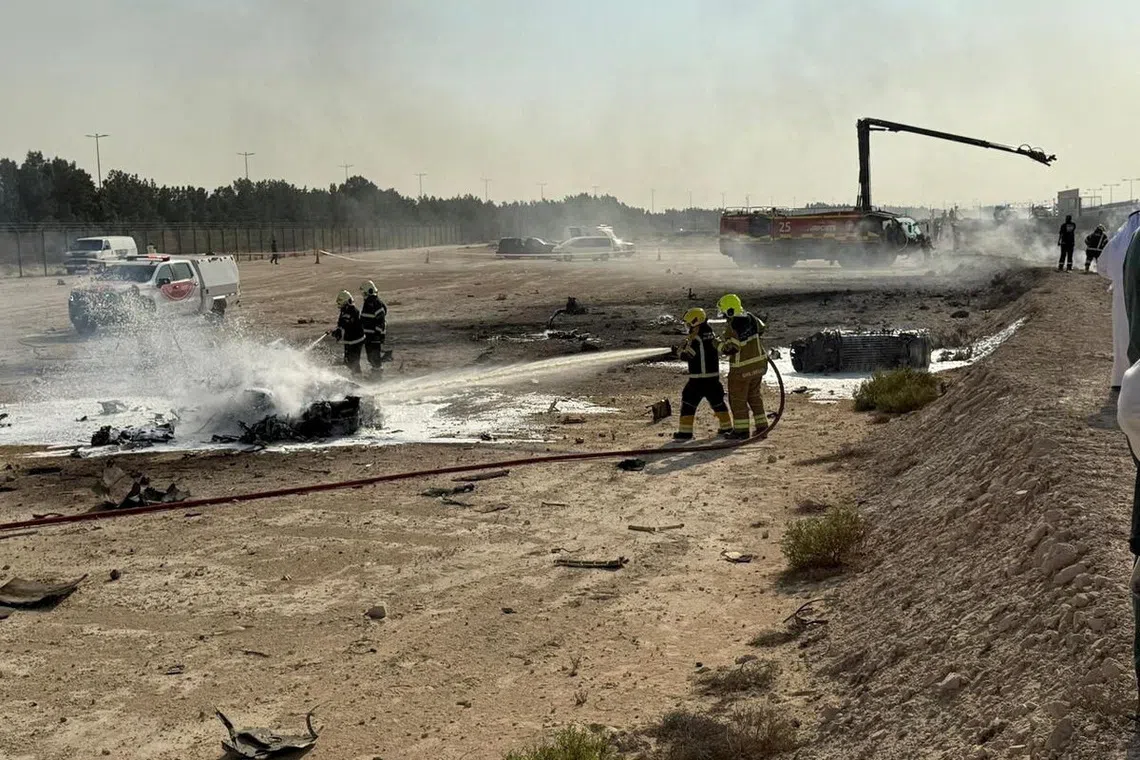Tejas crash dampens export hopes for Indian fighter jet
Sign up now: Get insights on Asia's fast-moving developments

Firefighters working at the site of the Tejas crash at the Dubai Airshow on Nov 21.
PHOTO: REUTERS
Follow topic:
NEW DELHI – The crash of India’s Tejas fighter jet in front of global arms buyers at the Dubai Airshow is the latest blow to a key national trophy, leaving the plane reliant on Indian military orders to sustain its role as a showcase of home-built defence technology.
The cause of the crash on Nov 21
Such a public loss will inevitably overshadow India’s efforts to establish the jet abroad after a painstaking development over four decades, experts said, as India paid tribute to Wing Commander Namansh Syal who died in the crash.
Crash at showcase event in Dubai
“The imagery is brutal,” said Mr Douglas A. Birkey, executive director of US-based Mitchell Institute for Aerospace Studies, referring to the history of crashes at air shows where nations and industries seek to tout major national achievements.
“A crash sends quite the opposite signal: a dramatic failure,” he noted, adding that while the Tejas would suffer negative publicity, it would most likely regain momentum.
Dubai is the world’s third-largest air show after Paris and Britain’s Farnborough, and accidents at such events have become increasingly rare.
In 1999, a Russian Sukhoi Su-30 crashed after touching the ground during a manoeuvre at the Paris Air Show, and a Soviet MiG-29 crashed at the same event a decade earlier. All crew members ejected safely and India went on to place orders for both jets.
Fighter jet sales “are driven by high order political realities, which supersede a one-off incident”, said Mr Birkey.
Powered by GE engines
The Tejas programme began in the 1980s as India sought to replace vintage Soviet-origin MiG-21s, the last of which retired as recently as September after numerous extensions due to slow Tejas deliveries by Hindustan Aeronautics.
The state-owned company has 180 of the advanced Mk-1A variant on order domestically but is yet to begin deliveries because of engine supply chain issues at GE Aerospace.
A former Hindustan executive who left the company recently said the crash in Dubai “rules out exports for now”. Target markets include Asia, Africa and Latin America, and the firm opened an office in Malaysia in 2023.
“The focus for the coming years would be on boosting production of the fighter for domestic use,” the former executive added, requesting anonymity.
But the Indian Air Force (IAF) is worried about its shrinking fighter squadrons, which have fallen to 29 from an approved strength of 42, with early variants of the MiG-29, Anglo-French Jaguar and French Mirage 2000 set to retire in coming years.
“The Tejas was supposed to be their replacement,” an IAF officer said. “But it is facing production issues.”
India is considering off-the-shelf purchases to fill immediate gaps, with options including more French Rafales, two Indian defence officials said, adding that India still plans to add to about 40 Tejas already in service. India is also weighing competing offers from the US and Russia for fifth-generation F-35 and Su-57 fighters – two advanced models also sharing a stage in a rare occasion in Dubai last week.
‘Base’ for future programmes
India has for years been among the world’s biggest arms importers, but has increasingly projected the Tejas as an example of self-reliance with Prime Minister Narendra Modi taking a sortie in the fighter in November 2023.
Like most fighter programmes, the Tejas has fought for attention at the intersection of technology and diplomacy.
Development was initially held up partly by sanctions following India’s 1998 nuclear tests as well as problems in developing local engines, said Dr Walter Ladwig, an associate fellow at the Royal United Services Institute in London.
But the jet’s long-term significance is “likely to lie less in sales abroad than in the industrial and technological base it creates for India’s future combat aircraft programmes”, he added.
Regional rivalry plays out
Both India and Pakistan were present in force at the show, where the Tejas performed multiple aerial displays in the presence of the rival Pakistani contingent.
Pakistan disclosed the signing of a provisional agreement with a “friendly country” to supply its JF-17 Thunder Block III fighter, co-developed with China.
On the ramp, a JF-17 was flanked by arms including PL-15E, the export variant of a family of Chinese missiles that US and Indian officials said brought down at least one French Rafale used by India during an aerial battle with Pakistan in May.
At the air show, manufacturer PAC gave out brochures touting the JF-17, one of two models deployed by Pakistan during the four-day conflict, as “battle-tested”. India is a lot more careful with the Tejas, which was not actively used in the conflict in May, Indian officials have said, without explaining why.
Nor did it participate in the annual Jan 26 Republic Day aerial display in New Delhi in 2025 due to what officials said were safety reasons associated with single-engine aircraft. REUTERS

